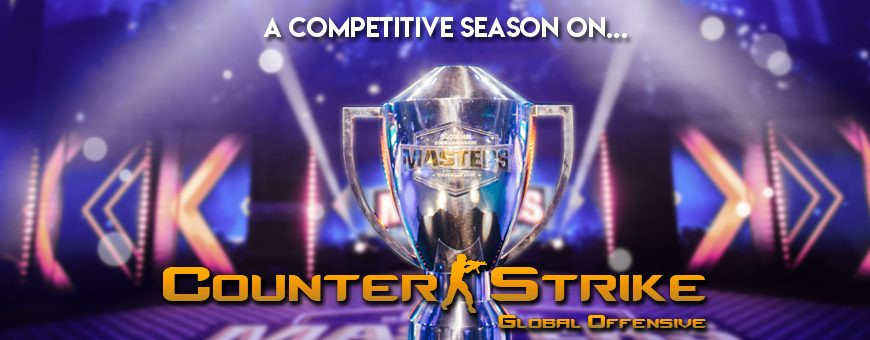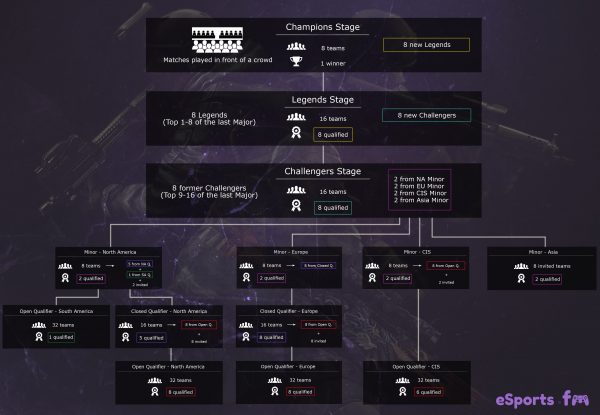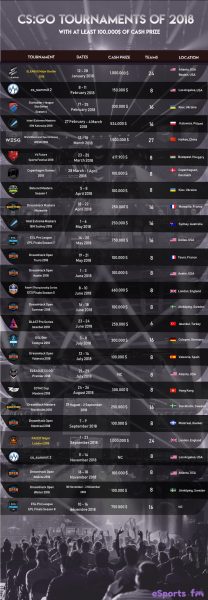A competitive season on Counter-Strike:Global Offensive

There are currently many debates on the relationship between sports and esports and the things they have in common or not, but everyone can agree that their competition formats, at least, are very similar to each other. And of course, just like in traditional sports, each game has its own established system. Most of them are pretty difficult to understand for the newcomers and for the part of the community that doesn’t usually follow the competitive scene. How many tournaments are there in a year? Which ones are the most important? Are there regional or national leagues? How do you designate the « best team in the world »? Many questions like these ones won’t find an answer unless you spend time reading news about the game and watching tournaments in order to understand that by yourself: there aren’t many in-depth articles or wikis on the web that will give you a proper and clear explanation to start with.
This new series of articles – « A competitive season on » – will introduce you to the different competitive systems of the most popular esports games, starting with Counter-Strike:Global Offensive. Compared to other games, CS:GO has an advantage: most of the major tournaments of a whole season are announced far in advance, which allows the teams to get prepared for their next destination, and the fans to take some days off. The downside is that such a large number of events certainly doesn’t help to understand and remember which ones are the most important. Let’s start from here.
Why are there so many tournaments on CS:GO?
The current version of Counter-Strike, called Global Offensive, was released in 2012 long after esports and their competitive scenes started flourishing on older games, such as Counter-Strike’s former versions Source and 1.6, or on the very famous Starcraft II. At that time, Starcraft II was the star of esports and was holding the record of the largest number of tournaments a year. Then CS:GO took the lead in 2015 and has never lost it since, with a record of 894 tournaments in 2017.
Number of tournaments per game in 2017 (Source: esportsearnings)
| Rank | Game | Number of tournaments |
|---|---|---|
| 1 | Counter-Strike:Global Offensive | 894 |
| 2 | Starcraft II | 612 |
| 3 | Super Smash Bros. Melee | 275 |
| 4 | Overwatch | 259 |
| 5 | Super Smash Bros. for Wii U | 200 |
| 6 | Dota 2 | 158 |
| 7 | League of Legends | 151 |
| 8 | Warcraft III | 124 |
| 9 | Hearthstone | 111 |
| 10 | Gwent: The Witcher Card Game | 88 |
| …13 | Rocket League | 66 |
| …17 | FIFA 17, Street Fighter V | 38 |
| …20 | Heroes of the Storm | 31 |
| …28 | Rainbow Six Siege, PlayerUnknown’s Battlegrounds, Halo 5, Gears of War | 14 |
The first key to this success is a well-established community that started growing in 1999 thanks to the former versions of the game, which as said above, have greatly contributed to the development of esports. Despite a difficult start – many people where reluctant to play on this new version at first – Global Offensive managed to bring together this community, older and newer fans, and acquired a large base of players and viewers.
But for a game to become a successful competitive electronic sport, you have to think about another aspect – the show. CS:GO’s rules are easy to understand and a match is easy to watch: you quickly distinguish the teams, the weapons, and the objectives. A few talented players can make a game as thrilling as a match of your favorite sport. Counter-Strike is a clever mix of spectacular actions and precise strategies, which can explain its growing popularity in Europe, America and Asia. Knowing all this, it doesn’t seem surprising that more and more tournaments are being organised on the game, to the point of dominating its MOBA rivals, which are less spectacular and more complicated for the newbies.
Are some tournaments more important than the others?
Some of these tournaments are obviously more important, more prestigious than others. Most tournaments enter the « amateur » category and welcome amateur or semi-professional teams on a national level. Their cash prizes are small and anecdotal, or even sometimes replaced by a provision of computer hardware.
International tournaments are considered as « important » when the cash prize reaches at least 100,000$, and the teams attending are part of the very top. These big tournaments can either start online or offline, but almost systematically have offline playoffs open to the public. They’re also set up by well-known organisations such as DreamHack or ESL, that have their own yearly competition circuit. Most important of all is the circuit organized by Valve itself, the developer, which is decisive in the teams’ world ranking and allows the best players to shine and establish their domination: the Major.
Are there regional leagues on the CS:GO scene?
Contrary to other esport games where regional leagues have developed their own circuits, Counter-Strike almost always gathers teams from different regions of the world during its international tournaments. Of course, there are still some local tournaments specific to Europe, North and South America or Asia, including regional qualifications for bigger tournaments. But except from that, and despite obvious inequalities in their respective levels, the different regions of Counter-Strike’s professional scene are not as compartmentalized as in other games. That is how the best French and Swedish teams are able to meet the best North American, Brazillian, Polish, Kazakh or Chinese teams in the most important tournaments.
Majors, how do they work?
The Majors are the most important and the most popular tournaments on CS:GO. They take place every six months and help to determine the current dominant, weak or rising teams, the current good players, and give for a brief moment the title of « best team in the world » to their winner. Their cash prize has reached 1,000,000$ and their live matches are watched by several tens of million people. But a Major is also special because of the hard path you have to go through to reach it. From several hundreds of teams at the beginning, only eight will get to play in front of the cheering crowd for the quarter-finals during the Champions Stage. Explaining the whole process is also quite of a journey, so let’s focus so you don’t miss any step (recap at the end for the tldr fans). Ready? Start:
From the bottom: the online qualifiers
In the beginning, Valve chose this special occasion to divide the Counter-Strike scene in four distinct regions: Western and Northern Europe (EU), America (NA), Eastern Europe and the Baltic states (CIS), and Asia. Thus, each region was given a chance to send its best teams to conquer the supreme title.
For this purpose, they first have to go through a Minor, last regional step before the best international teams are gathered to fight against each other. To participate in this Minor, each team has to go through one or sometimes several online qualifiers: the most “amateur” teams first enter an “open qualifier” that anyone can enter. Depending on the region, the six or eight best teams of this first round go to the “closed qualifier” to join some invited teams – which are automatically qualified to this stage thanks to their ranking or current form. Then the eight best teams of this second round go to their regional Minor, which is played offline.
One exception is the Asian qualification system: Asia automatically invites eight teams to their Minor without prior qualifications. This system has unsurprisingly received many critics as it looks like no chances are given to smaller teams in the region.
To get out of the region: the Minors
Several months before the actual Major, the teams who managed to overcome the qualifications are now trying to become the best of their region in order to get the opportunity to face the best teams in the world. Of course, earning such a position isn’t easy and the spots are limited, as only the two best teams of each region – the Minors’ finalists – will get their tickets for the most important tournament of the year.
The Minors aren’t usually played in front of a crowd, but many people watch them on streams to cheer for their favorites: there is a lot at stake, and for this occasion, many of the underdogs work hard to show their progress and beat the stronger teams.
First Stage of the Major: the Challenger Stage
They’ve finally done it. Two teams from Western Europe, two from Eastern Europe, two from America and two from Asia have survived throughout their regional qualifications and have reached the main event, the Major. These eight teams are now ready to face eight new contestants, the fallen Challengers, who placed between the ninth and sixteenth place of the last Major. While being unable to reach the quarter-finals six months ago, these teams still earned the privilege to avoid their regional qualifications – which, given what we have seen above, is a clear advantage – and wait for their new rivals.
Thus, the eight Minor winners fight the eight Major losers during the Challenger Stage in the hope of climbing one more step to the finals. The first eight teams become the new Challengers and advance to the Legends Stage, while the last eight teams will have to start once again from scratch, going back through the regional qualification for the next Major.
Almost there: the Legends Stage
To be fair, it is true that the path isn’t as hard for everyone, as some teams are assured to participate in the Legends Stage, last step before the quarter finals. The eight new Challengers are now ready to face the Legends, eight teams that have earned this status by placing first to eighth during the last Major. In other words, the ones who managed to reach the top six months ago have earned the right to remain there, given that at least three players out of five are the same as during the last Major. Big level here. But of course, the Legends are not unbeatable and have to fight to protect their title, while the Challengers have only one simple goal: reverse the roles and earn the very comfortable Legend status, that guarantees a spot for the next Major and brings you to the last, most important step: the quarter finals, or Champions Stage.
Clash of the Titans: The Champions Stage
The heat, the excitement, the deafening sound of the crowd, the pressure, the atmosphere inside the arena – all of this, only eight teams out of hundreds have the opportunity to know about it. The new Legends face each other in thrilling matches for the quarter-finals, semi-finals and grand final with only one goal in mind: to lift the trophy.
It would be wrong to say that these teams were “fortunate” to become Legends, knowing how hard the whole process is. This road to the Major is what gives such prestige to the tournament, and to the eight teams that manage to reach the top. They become the current best teams in the world. The rank, reputation, popularity and success of the teams and the players are heavily based on this difficult road, on the unexpected failures and victories, and on the quality of the games – some of which have already gone down in history.
Road to the Major: recap

So, what should I watch during the season?
You might have understood that contrary to some other games, there is no points-based system or annual circuit on Counter-Strike that would allow some teams to qualify for a Major – the most important events that happen twice a year – beforehand. Some teams keep their special status from one Major to another, while most of them fight in a special qualification circuit created for this sole purpose over a period of around three months before the Major itself. Other tournaments, no matter how important they are, have almost no influence whatsoever on it, except maybe to determine which teams get a direct invitation to the closed qualifiers or Minors.
Therefore, yes, there are many tournaments on Counter-Strike. All year long, almost continuously, fans get the opportunity to watch high-level online and offline games and cheer for their favorite top teams. DreamHack, ESL, ELEAGUE among other organizations work very hard in order to set up events on a regular basis all around the globe. Even if some of them are not as important or prestigious, they all offer their share of great show and thrilling games. To help you remember those tournaments considered to be “most important”, here is a recap of the 2018 season on Counter-Strike:Global Offensive (we will update it as new tournaments are announced during the year):
Main CS:GO tournaments in 2018 (with at least 100,000$ of cash prize)
| Tournament | Dates | Cash prize | Number of teams | Location |
|---|---|---|---|---|
| ELEAGUE Major Boston 2018 | 12 – 28 January 2018 | 1,000,000$ | 24 | Atlanta, United States Boston, United States |
| cs_summit 2 | 8 – 11 February 2018 | 150,000$ | 8 | Los Angeles, United States |
| Starladder i-league StarSeries – Season 4 | 17 – 25 February 2018 | 300,000$ | 16 | Kiev, Ukraine |
| Intel Extreme Masters – IEM Katowice 2018 | 27 February – 4 March 2018 | 524,000$ | 16 | Katowice, Poland |
| World Electronic Sports Games – WESG 2018 | 13 – 18 March 2018 | 1,500,000$ | 27 | Haikou, China |
| V4 Future Sports Festival 2018 | 23 – 25 March 2018 | 617,903$ | 8 | Budapest, Hungary |
| Copenhagen Games 2018 | 28 March – 1 April 2018 | 100,000$ | 8 | Copenhaguen, Denmark |
| Bets.net Masters Season 1 | 5 – 8 April 2018 | 100,000$ | 8 | Kiev, Ukraine |
| DreamHack Masters Marseille | 18 – 22 April 2018 | 250,000$ | 16 | Marseille, France |
| Intel Extreme Masters – IEM Sydney 2018 | 1 – 6 May 2018 | 250,000$ | 16 | Sydney, Australia |
| ESL Pro League – EPL finals Season 7 | 14 – 20 May 2018 | 750,000$ | 16 | Dallas, United States |
| DreamHack Open Tours 2018 | 19 – 21 May 2018 | 100,000$ | 8 | Tours, France |
| DreamHack Open Austin 2018 | 1 – 3 June 2018 | 100,000$ | 8 | Austin, United States |
| Esports Championship Series – ECS finales Season 5 | 8 – 10 June 2018 | 660,000$ | 8 | London, England |
| DreamHack Open Summer 2018 | 16 – 18 June 2018 | 100,000$ | 8 | Jönköping, Sweden |
| BLAST Pro Series – Istanbul 2018 | 23 – 24 June 2018 | 250,000$ | 6 | Istanbul, Turkey |
| ESL One Cologne 2018 | 3 – 8 July 2018 | 300,000$ | 16 | Cologne, Germany |
| DreamHack Open Valencia 2018 | 12 – 14 July 2018 | 100,000$ | 8 | Valencia, Spain |
| ELEAGUE CS:GO Premier 2018 | 21 – 29 July 2018 | NC | 8 | Atlanta, United States |
| ZOTAC Cup Masters 2018 | 24 – 26 August 2018 | 300,000$ | 8 | Hong Kong |
| DreamHack Masters Stockholm 2018 | 29 August – 2 September 2018 | 250,000$ | 16 | Stockholm, Sweden |
| DreamHack Open Montreal 2018 | 7 – 9 September 2018 | 100,000$ | 8 | Montreal, Quebec |
| FACEIT Major London 2018 | 1 – 23 September 2018 | 1,000,000$ | 24 | London, England |
| cs_summit 3 | 11 – 14 October 2018 | NC | 8 | Los Angeles, United States |
| DreamHack Open Atlanta 2018 | 16 – 18 November 2018 | 100,000$ | 8 | Atlanta, United States |
| DreamHack Open Winter 2018 | 30 November – 2 December 2018 | 100,000$ | 8 | Jönköping, Sweden |
| ESL Pro League – EPL finals Season 8 | 10 – 16 December 2018 | 750,000$ | 16 | NC |

– Article written by Tanéa Milesi
